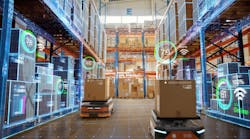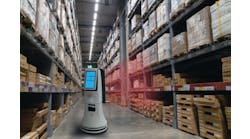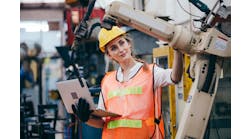By Tony Rigoni, director, industrial automation market development and alliances with Quanergy
Efficient warehouse operations keep costs low for companies, improve safety and keep customers happy. But there's a lot that can go wrong—everything from inventory not being shipped in time to things getting lost or on-the-job injuries. These all hurt the bottom line, reducing productivity and causing financial losses and damage to credibility.
Challenges persist, but one technology that is helping warehouses overcome hurdles is LiDAR.
Why LiDAR, why now?
LiDAR (Light Detection and Ranging) is the equivalent of radar technologies, but for the visible spectrum. Rapid light pulses are emitted by LiDAR at an object or the surrounding environment, and the amount of time it takes for the light to return is then measured.
Some LiDAR sensors offer mid- to long-range sensing capabilities, up to 250 meters, in support of a wide variety of industrial applications. LiDAR also performs reliably in harsh industrial environments and operates in any weather and/or lighting conditions, as well as indoor or outdoor.
Phased Array technology did a great job of transforming RADAR from mechanical to solid state. Today, the same transformation is happening for LiDAR. Solid-state LiDAR means that there are no moving or vibrating parts, which boosts reliability and dependability for even the toughest environments.
So, what does this actually mean for the warehouse?
Seven applications for the warehouse
We’re already seeing how LiDAR can transform warehouse operations and we’re only just scratching the surface in terms of its deployment.
Some of these applications include:
- Automation storage & retrieval systems (ASRS): Robots are used in an ASRS to select items from extensive rows of shelving. The robot is directed where to go in order to retrieve the item via computer software. If everything goes according to plan, that’s a great system. But what if the robot doesn't fully reposition the pallet or if a box drops in front of the robot? Fortunately, LiDAR can be used to identify the danger and prevent any harm to the robots.
- Bin-picking: If you've ever visited a sizable warehouse, you've probably seen the bins that the order-filling employees browse for items. The workers push a button to confirm that they took the item from the right bin. This system works, but setting it up costs money and takes time. This warehouse automation system is enhanced by today’s technology, which uses LIDAR scanners to set up virtual zones around the front of each bin. Using this easily implemented system, a warning sounds whenever a worker pulls from the incorrect bin. This boosts pick speed and accuracy, with better air-proofing.
- Packaging: Sensors can “count” product to determine if any is missing. They can also determine box dimensions and fill volume for greater packing efficiency and cost savings.
- Loading docks: Warehouse personnel in distribution facilities with hundreds of doors need to be aware of when the trucks have arrived and are prepared to roll up the doors. Forklifts could fall out of the loading bay, for one thing. And they want to keep the ambient air for cooling and heating inside as much as possible. Drivers would also like warehouse staff to know when they’ve arrived, so they don’t have to leave their trucks and hike in to tell them. Nowadays, every door has sensors. Every door needs to be wired, and sensors are very costly. Now, just one LiDAR sensor positioned on the building side can keep an eye on numerous doors, confirm when trucks arrive and alert the staff to the location of the trucks. This greatly improves distribution-center efficiency.
- Anti-collision systems: Many applications call for a straightforward zone presence identification of an object in order to prevent collisions. Purpose-built software can be run directly onboard LiDAR sensors, enabling the establishment of zones to deliver a straightforward digital output.
- Pallet/box dimensioning: Today's workers still use a tape measure to build and ship pallets. That takes a lot of time, and shipping firms charge a fine if you underestimate the size of the pallets. So, the workers round up their measurements by two inches. In short, they’re paying for two inches of space that they may not need. However, if they could electronically scan each pallet, they would not only save time but also money on shipping costs because they would know the exact capacity of each pallet. This application is currently being tested.
- Industrial robot solutions: Many of the mobile robots use today use a combination of 2D cameras, some coupled with 2D LiDAR. But the challenge with these technologies is that while the robot knows where it is, it doesn’t understand if a box or a person is in front of them. With next-generation 3D LiDAR, robots can do natural-feature navigation and can see potential objects/dangers around them, identify what they are, avoid the obstacle and pick a better path instead. They can also detect cliffs, so robots can perceive the ledge of a loading dock and not fall off it. In addition, organizations can now map a whole warehouse in less than an hour and deploy robots, rather than taking weeks or months to set up the infrastructure for your robotics.
LiDAR’s time has come
Today, industrial automation is a requirement for market viability. It improves productivity, safety and accuracy and while also saving time and money. LiDAR is an incredibly useful and versatile technology that can be used for everything from robot navigation to all other features of warehouse automation. The time has come to consider how this technology might enhance your business' bottom line through improved processes.



